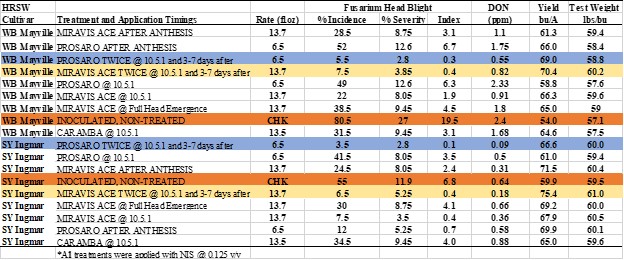Objective: To evaluate the efficacy of fungicides in single and sequential applications to manage Fusarium head blight (FHB) in hard red spring wheat (HRSW).
Methods:
Location: NDSU Langdon Research Extension Center
Experimental design: Randomized complete block with split plot arrangement, four replications.
Previous crop: Canola
Cultivars of HRSW tested: WB Mayville and SY Ingmar
Planting: 1.5 million pure live seeds/A planted on May 9, 2019. A border plot was planted between treated plots to minimize interference from spray drift.
Plot size: Seven rows at six inch spacing, 5 ft. x 20 ft., mowed back to 5 ft. x 16 ft.
Herbicides applied: Axial XL (16.4 Fl. oz/A) + Huskie (15 Fl. oz/A) + Prowl H2O (36 Fl. oz/A)
Inoculation: Plots were inoculated by spreading corn spawn inoculum around boot stage (Feekes 9-10) at the rate of 300 g/plot.
Disease development: Supplemental moisture was provided by running overhead irrigation from Feekes 9 to 11.2.5 at the rate of one hour per day to create a conducive environment for FHB development.
Fungicide treatments: Fungicides were applied with a CO2-pressurized backpack sprayer with a three-nozzle boom (XR-8002) and the water volume used was 20 GPA. Fungicide (Miravis Ace) application was made at full head emergence on July 3rd. Miravis Ace, Prosaro and Caramba were applied at Feekes 10.5.1(anthesis) on July 5th and repeated 5 days after the first spray (July 10th) based on protocol recommendations. Refer to Table 1 for the treatments, dosages and application timings.
Disease assessment: Data on FHB incidence was obtained by counting the number of heads showing FHB symptoms out of 50 heads. FHB head severity was rated using 0-100% scale on arbitrary 50 heads, excluding two outer rows. FHB index (Index) was calculated using formula: Index = (SEV*INC)/100.
Harvest: Plots were harvested on September 4th with a small plot combine and the yield was determined at 13.5% moisture.
Data analysis: Statistical analysis was done using Agrobase. Fisher’s least significant difference (LSD) was used to compare means at p (α = 0.05). Actual means were presented in the table for simplicity of understanding.
Table 1: Evaluation of commercially available fungicides at various application timings to manage Fusarium Head Blight on Hard Red Spring Wheat.
Results: Fusarium head blight (FHB) incidence, severity, index, and Deoxynivalenol (DON) content were significantly different (p-Value = 0.007) among the cultivars, likewise, with fungicide applied at different timings (p-Value = 0.00001). Yield in various tested treatments was significantly different between the cultivars and among the non-treated check and the fungicide treatments.
Table 2: Fusarium Head Blight (FHB) Incidence, Severity, Index, Deoxynivalenol (DON) and Yield from Miravis Ace treated plots on two Hard Red Spring Wheat (HRSW) cultivars at various application timings.
Results: Fungicide Miravis Ace when applied early (Full Head Emergence) and at 3-7 days after 10% flowering stage of HRSW was similar in managing FHB and in yield. However, there were significant differences in DON contents (LSD = 0.2) in cultivar SY Ingmar, but not in the cultivar WB Mayville. Solo treatment of Miravis Ace applied at 10% flowering was best among the three application timings in cultivar SY Ingmar, no such difference was observed in the cultivar WB Mayville.
Funded By: US Barley and Wheat Scab Initiative Project and Syngenta.

